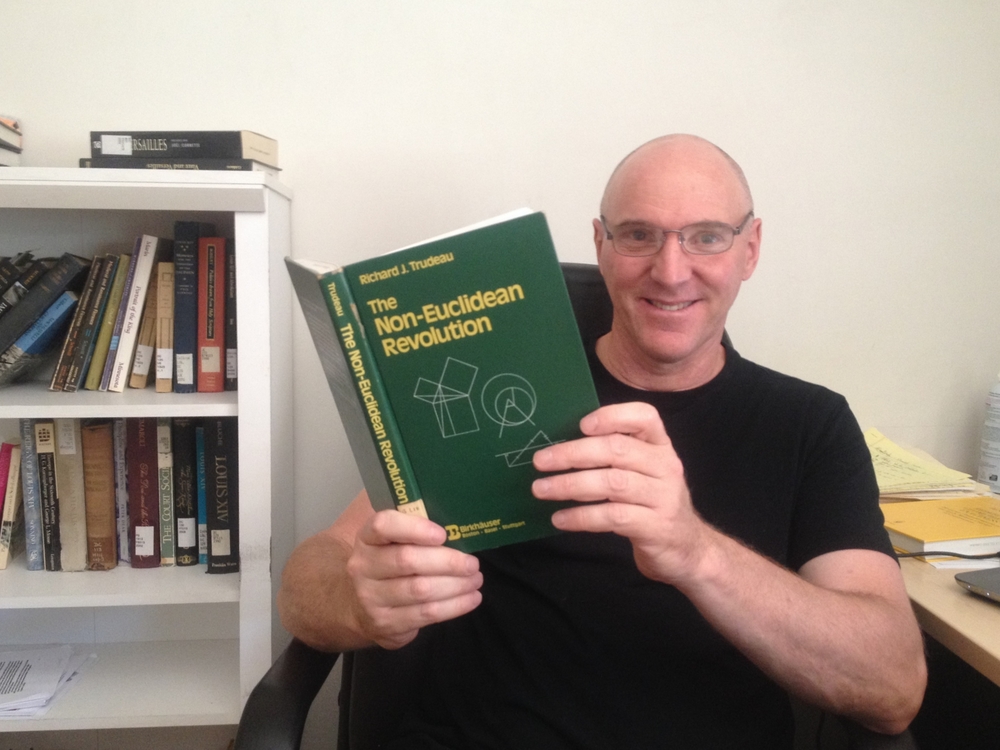
Historian of Mathematics Amir Alexander investigates math’s history and the different people, places, and even religions which shape it.
What’s your favorite subject in school?
Does math ever seem simpler to you — or at least tidier — than history, English, and other subjects? Sometimes it can be comforting to work on problems that have one correct answer. The idea that math is grounded in simple, unchanging rules reassures people looking for straightforward, or at least right (as opposed to wrong) answers.

But math itself — or at least our understanding of how to do math — changes with the times. And when those times themselves are full of change, math and the people who do it can become controversial.
Math is a way of ordering the world, and because of this mathematicians’ ideas have “implications for humanity: for political order, for social order,” and even “for religion.” When you learn math, “it’s so abstract,” says Historian of Mathematics Amir Alexander. It can seem very dry, focusing on “universal theorems that apply everywhere and always in the universe, regardless of people.” But studying its history “gives mathematics a human face.”
After the philosopher Martin Heidegger became rector of Nazi Germany’s Freiberg University in 1933, he fired Jewish professors, including Alexander’s grandfather, a professor of physics. Before the situation in Germany declined further, Ernst Alexander emigrated and went on to help found the physics department at Jerusalem’s Hebrew University.
“My father [Shlomo Alexander] was also a physicist, and he was even more mathematically oriented than my grandfather: he loved mathematics. I always had the sense, growing up in that environment, that there was something almost magical about mathematics.” When his father talked about numbers, “he would have this gleam in his eye.” Wondering what all the excitement was about, young Amir decided to “at least get a glimpse of that.”
Alexander’s degrees are in mathematics, history, and the history of science. “My interest is not just in the history of math as mathematics but really the interconnections between mathematics and the broader world of culture, religion, art, and politics.”
Math (and especially the ideas that led to what we now call “calculus”) got tangled up in Europe’s religious battles after the Reformation. Alexander’s most recent book, Infinitesimal, describes “two kinds of mathematics that were being presented at the time by the two opposing sides. On the one side were the Jesuits: they believed that mathematics should provide absolute order and stability and guarantee the existing hierarchies in the world.” Their goal was to support the Catholic Church as it struggled against newer (Protestant) versions of Christianity.
“The kind of mathematics they had in mind was Euclidean geometry.” The proofs you learn in geometry class involve a step-by-step logic based on “very simple, self-evident postulates” that “create a whole geometrical world in which everything is known.” The Jesuits loved geometry because it seemed “stable, fixed, unchanging — and that’s the kind of world that the Jesuits wanted to create.”
“On the other side, there was a very different kind of mathematics that ultimately led to the development of the calculus, based on the infinitesimals, as they were called at the time.” What are infinitesimals? You might think of them as the infinite number of points that make up a line, or the infinite number of lines that make up two-dimensional space (a plane).
Mathematicians working with infinitesimals at the time were willing to imagine the idea that zero-dimensional objects (points) might combine to create one-dimensional objects (lines). Similarly, one-dimensional objects (lines) might combine to create two-dimensional objects (planes). Two-dimensional objects (planes) might combine to form three-dimensional space. This might seem to make sense: the number 4 on the number line is one point. Slice through a square and you have a line segment. Slice through a three-dimensional shape (e.g. a cylinder) and you have a two-dimensional shape (e.g. a circle). But, says Alexander, “while this is intuitively convincing, it’s also extremely problematic.”
“The Jesuits are absolutely right — you can’t move from one dimension to the other; you can’t say that a one-dimensional line is made up of zero-dimensional points.” But “what is interesting is that the descendants of” Galileo Galilei, people like Bonaventura Francesco Cavalieri, used these ideas to “muddle through and get some results.” They demonstrated a willingness to experiment with math, to accept “the fact that there are paradoxes and that we don’t understand things through and through.”
One example of this type of experimentation is Cavalieri’s proof that drawing a diagonal across a parallelogram creates two congruent triangles. Instead of proving their congruence in the (Euclidean) way you may have learned to do in geometry class (think SAS), Cavalieri noted that “each triangle is made up of lines, one next to the other, next to the other. And each line in one triangle has an equivalent in the other triangle.” If you could add all of these lines up, “you [would] get equal areas.”
Alexander explains that Cavalieri’s method of proof is “not mathematically rigorous” (which is probably why it’s not the one you learned in your geometry class). But it is “intuitively appealing” and Cavalieri went on to use it to explain more complicated things, such as how to find the area inside an Archimedean spiral.
In England around this time, Mathematician John Wallis “wanted mathematics that was quick and easy and produced results.” He was criticized for doing a “hands-on, intuitive” form of math, exploring whether what seemed to work for one number and another might be said to work for all numbers. (This was an early form of induction, a type of proof accepted now.) Says Alexander, Wallis “was looking for patterns. If he saw patterns in a few cases, then he would say “Ok. I think this will work for anything.’”
Thomas Hobbes, a British political philosopher, modeled his book Leviathan on Euclid and did not much like Wallis’s math. Wallis suggested that we should not assume there are absolute truths in the world. But Hobbes based his politics on the idea that there are absolute truths and that the best political philosophy (his) must be based on those truths, just as geometry and its proofs are built from postulates. He wanted a society that was orderly, hierarchical and never-changing, just like geometry.
Compare Hobbes’s insistence on absolute truths with Wallis’s use of the idea of infinity. Wallis invented the symbol we use for infinity (∞), a number bigger and also smaller than any other. Does infinity exist? Your math teacher will probably tell you that it does not, but that did not stop Wallis from using it in his formula for the area of a triangle. In this kind of thinking lie “the wild and wooly origins of calculus,” explains Alexander.
These types of conflict continued into the eighteenth century, when Bishop George Berkeley criticized Isaac Newton and the ideas on which calculus was founded. He made fun of infinitesimals, the tiny quantities used by Galileo, Cavalieri, and their descendents, ideas that eventually helped Newton and Gottfried Wilhelm Leibniz invent calculus. According to Bishop Berkeley, infinitesimals were no more than the “ghosts of departed quantities.” Math had become monstrously imaginary!
It was only in the 19th-century that Mathematician Augustin-Louis Cauchy managed to make the calculus as mathematically rigorous as geometry. He did so by separating math from physical reality. Earlier mathematicians thought of math as the deep order of nature, but Cauchy insisted that math does not have to represent things we can see in the physical world. He said that the infinitesimal was a “pure algebraic concept,” says Alexander. A limit, for instance, can exist mathematically. We do not have to find the point in space where it exists to understand and to use it in math. Thanks to Cauchy, math became more rigorous, but also more insulated from reality.
Alexander is fascinated by the century of Cauchy, when “the image of mathematics and the persona of mathematicians changed,” separating from the connection they had to the physical world. From the 19th century on, stories about mathematicians described them as “other-worldly creatures, misfits, with their heads in the stars.” They were seen as people who “often come to a bad end” as does Alan Turing, in The Imitation Game.
Today, computers and other forces may be changing our understanding of math and the stories we tell about it. Alexander observes that there is a “strong movement to integrate computers into the practice of mathematics. They are cumbersome, physical things with wires. They hum. They are … material, mechanical things. There’s a strong opposition among some mathematicians [to] using them; but there’s also a strong movement” that promotes the use of computers as “the future, the way to go now. I think that stories about mathematics will change along with it.”


